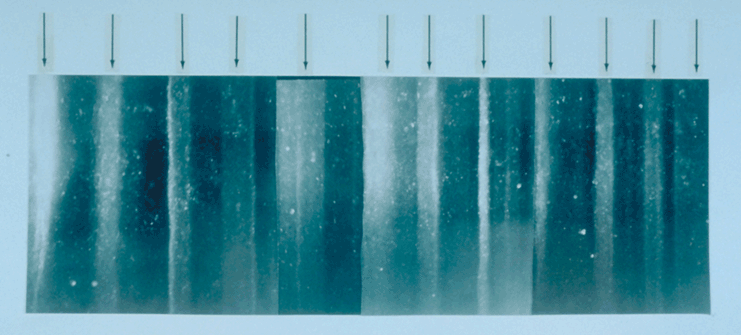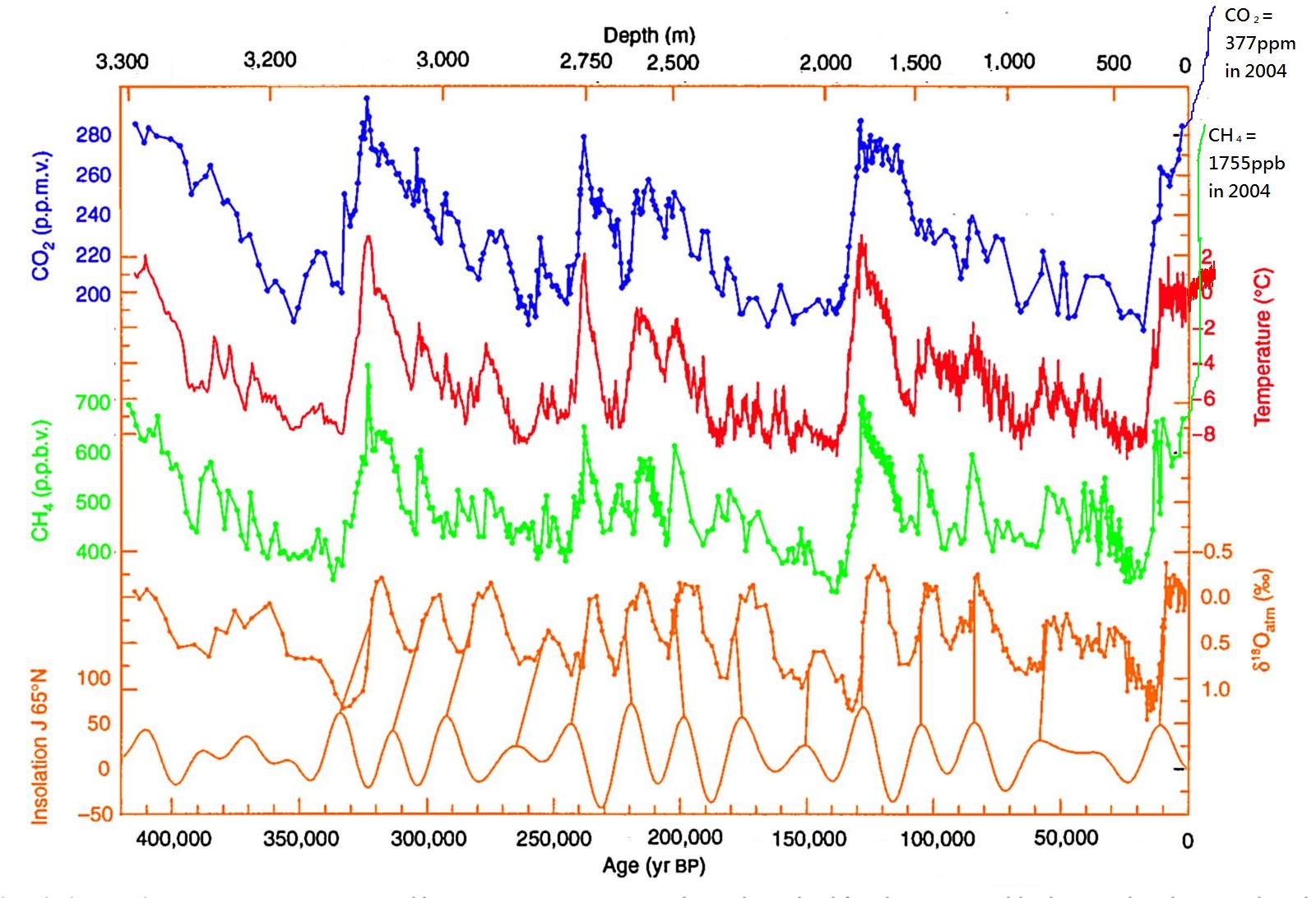What Are Ice Cores?
Ice cores are cylinders of ice drilled from thick ice sheets in places like Antarctica and Greenland. These ice sheets formed as snow fell year after year for hundreds of thousands of years, gradually compressing into solid ice.
Each year's snowfall creates a distinct layer in the ice, much like tree rings. These layers contain detailed information about the climate and atmosphere when they formed.

What Makes Each Year's Layer Different?
Scientists can identify individual years because each annual layer has unique characteristics:
- Summer vs. Winter Snow: Summer snow is often lighter and less dense, while winter snow is denser and contains more dust.
- Chemical Signatures: Each season brings different chemicals—sea salt in winter storms, dust from spring winds, different acid levels from vegetation.
- Air Bubbles: As snow compacts into ice, it traps tiny bubbles of ancient air, preserving actual samples of past atmospheres.
Counting Annual Layers
In the upper sections of ice cores, scientists can directly count individual years by examining several indicators that change seasonally:
Visual Counting
Many annual layers are visible to the naked eye due to differences in ice texture, bubble density, and dust content. Scientists can literally count backwards year by year, like counting tree rings.
Chemical Analysis
Even when layers aren't visually distinct, sophisticated instruments can detect seasonal chemical cycles:
- Dust and Sea Salt: More dust in spring/summer, more sea salt in winter storms
- Acidity: Varies seasonally due to biological activity and atmospheric chemistry
- Isotopes: The ratio of heavy to light isotopes changes with temperature, creating annual cycles

Multiple Independent Counts
Scientists don't rely on just one method. They count layers using visual examination, chemical analysis, and electrical measurements. When all methods give the same count, this provides confidence in the results.
How We Verify the Counts Are Accurate
Scientists use several methods to confirm that their layer counts correctly represent actual years:
1. Known Historical Events
The ice contains clear markers from events we know happened in specific years:
- 1963 Nuclear Testing: Atmospheric nuclear tests in 1963 created unique radioactive markers that appear exactly where the count says 1963 should be
- Famous Volcanic Eruptions: Major eruptions like Tambora (1815) and Laki (1783) left distinctive acid spikes in the ice at precisely the counted depths for those years
- Recent Pollution: Industrial pollution markers appear exactly where expected based on the counts
These "known-year anchors" prove the counting method works (Sigl et al. 2015; Zielinski 1995).
2. Multiple Independent Ice Cores
When scientists count layers in different ice cores from the same region, they get the same results. When they match up major volcanic eruptions between cores from Greenland and Antarctica, the counts align perfectly.
3. Cross-Checking with Other Records
Ice core chronologies match up with tree ring records, lake sediments, and other annual climate records, providing multiple independent confirmations.
The Bottom Line on Verification
The annual layer counts have been verified against known historical events, multiple independent ice cores, and other annual records. The counting method demonstrably works for periods we can verify, giving confidence in older sections.
Dating Deeper Ice
As ice gets deeper and older, the annual layers become compressed and eventually too thin to count individually. For these deeper sections, scientists use other methods:
Reference Points from Volcanic Eruptions
Major volcanic eruptions create distinctive markers that can be identified across multiple ice cores and matched to known eruption dates from geological records. These create "anchor points" in the deeper ice (Sigl et al. 2015).
Ice Flow Models
Ice flow models use physics to calculate how ice accumulates and flows over time. These models are constrained by:
- Known accumulation rates at the surface
- The counted annual layers in upper sections
- Volcanic anchor points at known depths
- The physics of how ice compresses and flows
Matching Between Ice Cores
Scientists match patterns in atmospheric gases (like methane) and volcanic signatures between ice cores from different locations. Since these atmospheric changes were global, they provide synchronization points (Blunier & Brook 2001).
Multiple Independent Methods
The key point is that multiple independent approaches—annual layer counting, volcanic markers, ice flow physics, and inter-core matching—all give consistent results. This provides strong confidence in the chronology.
What the Evidence Shows
The ice core record presents clear evidence for timescales far exceeding a few thousand years:
Greenland: Over 50,000 Counted Annual Layers
In Greenland ice cores, scientists have directly counted more than 50,000 individual annual layers using multiple independent methods. These counts are verified by known historical markers and match between different ice cores (Meese et al. 1997; Svensson et al. 2008; NGRIP Members 2004).
Antarctica: Hundreds of Thousands of Years
Antarctic ice cores like EPICA Dome C extend back over 800,000 years, preserving records of multiple ice ages. These chronologies are built using annual layer counts in the upper sections, volcanic synchronization points, and ice flow models that are constrained by known physics (Petit et al. 1999; EPICA 2004; Jouzel et al. 2007).
Global Synchronization
Ice cores from Greenland and Antarctica can be synchronized using atmospheric gases and volcanic events that affected both hemispheres simultaneously. This creates a globally consistent chronology without relying on radiometric dating (Sigl et al. 2016).
Climate Cycles Match Astronomical Predictions
The ice cores show climate cycles that match calculated changes in Earth's orbit (Milankovitch cycles). These orbital changes are predictable based on gravitational physics, providing an independent check on the ice core chronology.
Key Point: This Evidence Doesn't Rely on Radiometric Dating
The ice core chronology is built primarily on counting annual layers, identifying volcanic events, and applying known physics of ice flow—not on radiometric assumptions. Even if someone questions radiometric dating methods, the ice core evidence independently points to timescales far exceeding Young Earth proposals.
Conclusion
Ice cores provide a straightforward, observable record of Earth's climate history through annually deposited layers of ice. The evidence is compelling because it relies on direct observation and counting rather than complex theoretical assumptions.
What We Can Directly Observe
- Annual layers visible to the eye and detectable by instruments
- Chemical signatures that vary predictably with seasons
- Known historical events (volcanic eruptions, nuclear testing) appearing at the expected depths
- Consistent results across multiple ice cores and counting methods
The Conservative Minimum
Even taking the most conservative approach—accepting only the directly counted annual layers in Greenland ice cores and the known historical markers that verify them—the evidence shows continuous ice deposition for over 50,000 years.
The Broader Picture
When ice flow physics, cross-core synchronization, and Antarctic records are included, the evidence extends to approximately 800,000 years of Earth history preserved in ice—multiple ice ages and warm periods in a continuous, layer-by-layer record.
Why This Matters
Ice cores represent one of the clearest, most direct records of Earth's history available to science. The methods are straightforward, the results are reproducible, and the timescales revealed extend far beyond what Young Earth chronologies can accommodate. This evidence stands independently of debates about radiometric dating or other dating methods.
For a detailed technical summary with additional citations, see: assets/data/ice.txt
Key Scientific References
Annual Layer Counting & Verification:
- Meese DA, Alley RB, Gow AJ, et al. 1997. GISP2 depth–age scale. J Geophys Res. doi:10.1029/97JC01266
- Svensson A, Andersen KK, Bigler M, et al. 2008. 60,000-year Greenland stratigraphic chronology. Climate of the Past. cp.copernicus.org/articles/4/47/2008/
- NGRIP Project Members. 2004. High-resolution record into the last interglacial. Nature. nature.com/articles/nature02805
- Sigl M, Winstrup M, McConnell JR, et al. 2015. Volcanic forcing for 2,500 years. Nature. doi:10.1038/nature14565
- Zielinski GA. 1995. Explosive volcanism since 1100 AD from GISP2 sulfate. J Geophys Res. doi:10.1029/95JD01751
Cross-Core Synchronization:
- Blunier T, Brook EJ. 2001. Greenland–Antarctica timing via CH4. Science. doi:10.1126/science.291.5501.109
- Sigl M, Fudge TJ, Winstrup M, et al. 2016. WAIS Divide volcanic chronology. Climate of the Past. cp.copernicus.org/articles/12/769/2016/
Long-Term Antarctic Records:
- Petit JR, Jouzel J, Raynaud D, et al. 1999. Vostok 420 kyr climate and atmosphere. Nature. doi:10.1038/20859
- EPICA Community Members. 2004. Eight glacial cycles (Dome C). Nature. doi:10.1038/nature02599
- Jouzel J, Masson‑Delmotte V, Cattani O, et al. 2007. Antarctic climate over 800 kyr. Science. doi:10.1126/science.1141038
Chronology Development:
- Andersen KK, Svensson A, Johnsen SJ, et al. 2006. GICC05 15–42 ka. J Geophys Res. doi:10.1029/2005JD006079
- Buizert C, Sigl M, Severinghaus JP, et al. 2015. WAIS Divide chronology (WD2014) 0–31 ka. Quaternary Sci. Rev. doi:10.1016/j.quascirev.2015.10.013
- Bazin L, Landais A, Lemieux‑Dudon B, et al. 2013. AICC2012 (optimized dating). Climate of the Past. cp.copernicus.org/articles/9/1715/2013/
- Veres D, Bazin L, Landais A, et al. 2013. AICC2012: 120–800 ka. Climate of the Past. cp.copernicus.org/articles/9/1733/2013/